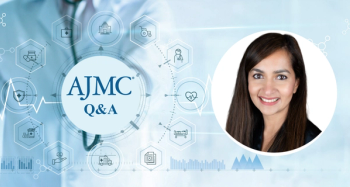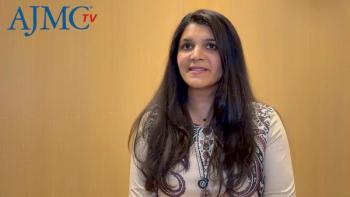
- December 2022
- Volume 28
- Issue 8
- Pages: SP518
Parsing Out the Necessary Elements for a Patient-Centric Strategy in Oncology
Coverage from the Institute for Value-Based Medicine® event with Oncology Consultants of Houston, held in Texas on October 11, 2022.
After the tumultuous past few years, most health care leaders agree that health care equity and patient-centered care is important. How to address these issues in the face of rising costs, worse outcomes, workforce challenges, and another round of CMS pilots and regulatory changes is another matter.
“The last 2 years have really exacerbated what many of us in health care understood as problems in the delivery model,” said Alti Rahman, MHA, MBA, the practice administrator of Oncology Consultants of Houston, which partnered with The American Journal of Managed Care®’s Institute for Value-Based Medicine® for the event, held in Texas on October 11, 2022.
Rahman served as moderator, and the speakers were as follows:
- Jonathan Coggins, MHA, vice president, chronic disease strategy and operations, McKesson
- Michael Kolodziej, MD, FACP, vice president and chief innovation officer at ADVI Health
- Bo Gamble, director of strategic practice initiatives at the Community Oncology Alliance (COA)
- John Sargent, MD, founding partner of BroadReach, a social enterprise health care consulting firm
- Susan Sabo-Wagner, MSN, RN, OCN, executive director of clinical strategy for Oncology Consultants
- Tesh Khullar, MBA, cofounder and president of HouseRX
- Sudipto Srivastava, MS, MBA, vice president, digital solutions, Hospital for Special Surgery
During the evening, Sargent, who has spent most of his career working in impoverished countries, presented results of his organization’s first State of US Health Equity Survey.
“Recent studies by Deloitte have shown that we lose roughly $320 billion of wasted costs in the health care system every year due to social determinants of health [(SDOH] and health inequities,” he said. Those losses will reach an estimated $1 trillion by 2040, he noted, adding that these issues also cause about $40 billion in lost productivity.1
Earlier this year, a unit of BroadReach surveyed 192 health care executives, mostly from payer organizations, to understand how organizations think about health inequities.2 The survey results indicated that while the industry sees health equity as very important, they have virtually no concrete plans to address it. Moreover, they know little about the race, ethnicity, or language of their customers or their staff, and few plan to prioritize health equity improvements in the coming year.
Organizations cited various barriers to implementing health equity initiatives, and the primary one related to data issues: lack of data, having incomplete data, and a lack of infrastructure to capture data, for starters. Other barriers included constraints due to budget, leadership, guidelines and governance, resource issues, timing and prioritization, and training and knowledge.
Sargent noted that his perspective was shaped by working in environments in which there were “extreme SDOH issues, and extreme health equity issues….[We were] trying to solve those and now [we’re] trying to take some of these lessons learned back into the United States.”
Organizations lack incentives to change in both the financial and regulatory realms, Sargent said.
“What can we learn from global health around health equity?”
asked Rahman.
The issue with data and analytics, Sargent said, is that when you give them to a burned-out, underresourced health care manager in a country where the government spends as little as $30 or $40 per patient per year, there is no way to make sense of the information, and thus no real tools to implement anything.
“When you show a manager who’s managing multiple hospitals a bunch of cool graphs, and say, hey, you can better manage now with all these cool graphs, they just go back and they focus on what they need to do,” Sargent exclaimed. “They’ve got do too much work to interpret these graphs to see what they need to do.”
The focus needs to be on the output of the information so that each worker can be told specifically how to address current challenges, he said.
In addition, it is crucial to work with local groups to improve health literacy as well as to get the buy-in of trusted local leaders, in order to change health behaviors in various countries, especially those with multiple tribes and numerous official languages.
Asked what organizations can do in the United States, Sabo-Wagner replied that a patient’s zip code gives an important clue into fully understanding population health needs.
“The biggest indicator for a patient or a person—and the biggest indicator that will cause a health outcome to be bad—is their zip code. It has nothing to do with smoking or eating bad or obesity, it’s their zip code.”
Sabo-Wagner also noted that Oncology Consultants has expanded a pilot program of using community health workers to conduct SDOH needs assessments and match patients to resources. The program is now practice wide.
Staff have to be empowered to act, Sargent said. Despite all the investment in SDOH and the data that are being generated, he said, the data aren’t simple and actionable.
What is needed in addition, he said, is an “enabling environment.”
Sargent continued, “I think the real issue is that people are hesitant to take action until they know what what’s going to happen in terms of regulations, and what is CMS going to do.”
Health equity is a required component of the latest 5-year pilots from the Innovation Center of CMS, including the Enhancing Oncology Model and the Accountable Care Organization (ACO) REACH model (Realizing Equity, Access, and Community Health). And the National Committee for Quality Assurance has created a health equity certification.
“So, it is sort of moving there. But I don’t think it’s moving fast enough to really compel organizations to really move,” Sargent said.
“Shocking” Results on US Health Care Spending, Outcomes
Earlier in the evening, Coggins presented a familiar overview of the current woeful state of US health care spending and outcomes, as compared with other countries.
Coggins outlined McKesson’s analysis of international economic data from the Organization of Economic Cooperation and Development (OECD), including health spending as a percentage of gross domestic product (GDP), health spending per capita, health care spending by category, life expectancy, health outcomes, quality of care, and the value of care.
The analysis looked at a subset of 11 of the 36 countries in the OECD with which the United States has most in common.
“The results are pretty shocking,” Coggins said.
For instance, despite the fact that US health care spending is approaching almost 20% of GDP, Americans have the lowest life expectancy of residents in any Western country and the highest percentage of adults living with at least 1 chronic condition.
However, despite the bad news on every OECD metric, Coggins touted one bright spot, using a report from the Foundation for Research on Equal Opportunity (FREOPP), a free enterprise think tank that champions technological innovation.
Last year, FREOPP released an index looking at world health care innovation, which ranked countries on the metrics of fiscal sustainability, quality, and science and technology. The United States ranked first in science and technology; however, it ranked in third-from-last place in fiscal sustainability, ahead of Japan and France.3
“We are anticipating that we’ll shift the value-based care equation pretty substantively over the next decade, going from an exclusively value-based care plateau and shifting it to a transformative plateau,” Coggins claimed. In his view, the onus will be on primary care organizations to focus on preventative care to “to alleviate the cost-of-care burden.”
The shift will largely happen outside of the direct therapeutic space and, instead, take place within nontherapeutic health care investment areas, like technology and access. Those investments last year totaled almost $100 billion, he said.
The conversation then turned to what the landscape will look like for oncologists in the years ahead. Most will be working for hospitals, Kolodziej explained. In 10 years, there has been a 26% increase in the number of physicians employed by hospitals; about 50% of all doctors now do so.
“If you’re an oncologist, the hospitals are welcoming you with open arms. They love you. [But] why do they love you?” Kolodziej asked rhetorically. The answer, he said, is because of patients with commercial insurance, since hospitals earn a percentage of billed charges. “So, I call the hospital chargemaster your list to Santa Claus, how much you want to get paid. And then the contracts pay the hospital a percent of that. And it’s a lot.”
But it is more than just the hospitals employing oncologists for the future changes he sees coming for specialists in the future—Kolodziej also blamed the 340B drug program, which has been criticized for plumping up the profits of wealthy hospitals, and alternative payment models such as ACOs, of which he is not a fan.
“I’m saying that the idea that we live in this oncological cocoon is false. We are going to be held accountable—whether it be to hospitals, because we make them a lot of money; whether it’s because we’re part of ACOs, which I must say to this point, have not done a very good job with oncology care; or [to] health plans or another third party. We will be held accountable,” he stressed.
“Physicians are either going to be employed or subcontracted,” Kolodziej said, calling it an eventual path to a single-payer health care system, if, he later clarified, nothing else improves.
“We are facing a world where I think value-based care is going to mean doing all the things we do very, very well but answering to different bosses,” he said.
Kolodziej and Gamble were asked by Rahman to give their thoughts about the various payment models and their iterations. Rahman queried whether “we are going in the right direction in terms of quality and quality measures. What does that actually means in terms of quality for the patient? Are all these models moving in that direction?”
To no one’s surprise, both panelists were critical.
“They’re incredibly complex,” Gamble said of the models. “I would like to see someone that’s got a great model that’s somewhat simple, that people could say, yes, I can follow that, and I can implement that. But so far, nothing is transferable, is scalable, for other people to do it,” he said.
Quality measures, Kolodziej added, are mostly an afterthought.
“And part of that, honestly, it’s our fault—our fault being us, the oncologists, because we actually have been unable to articulate what quality means in a cancer patient.”
Patient Access to Data
Rahman ended the evening with a discussion seeking some practical takeaways with Khullar and Srivastavca, after their respective presentations about future trends, including pharmacy benefit managers and the push for transparency, the Inflation Reduction Act (IRA), and improvements to watch for in digital health.
Implementing the IRA will take 3 election cycles, Khullar said, but another notable event to watch for is the part of the 21st Century Cures Act that took effect on October 6, which ends so-called information blocking of health data. The Cures Act directs the Office of the National Coordinator for Health Information Technology to create a standardized process through which patients can request access to all of their electronically protected health information in designated record sets.
Start-up companies likely will create opportunities to help consumers pull their information from different sources and make sense of it, said Srivastavca, who also said he is looking forward to the transparency enabled by the Cures Act.
References
1. Dhar A, Bhatt J, Batra N, Rush B, Gerhardt W, Davis A. US health care can’t afford health inequities. Deloitte Insights. June 22, 2022. Accessed November 12, 2022. http://bit.ly/3g1HHvx
2. Wider J. Survey: health equity is a priority but barriers remain. Healthcare Innovation. August 2, 2022. Accessed November 14, 2022. http://bit.ly/3TCX4br
3. Roy A. Key findings from the 2021 FREOPP World Index of Healthcare Innovation. FREOPP.org. June 25, 2021. Accessed November 14, 2022. http://bit.ly/3EuDbih
Articles in this issue
about 3 years ago
Innovation in a Time of Scarcityabout 3 years ago
PBM Fees Put the “GER” in Danger for Specialty Pharmaciesabout 3 years ago
Clinical Updates: Fall 2022about 3 years ago
Managed Care Updates: Fall 2022about 3 years ago
FDA Actions: Fall 2022about 3 years ago
OneOncology Physician Leadership Conference: Inaugural Meeting 2022about 3 years ago
COA Payer Exchange Summit: 2022 CoverageNewsletter
Stay ahead of policy, cost, and value—subscribe to AJMC for expert insights at the intersection of clinical care and health economics.





























































